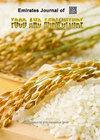Determination of bioactive properties of Capparis spinosa fruits and use in production of Tulum cheese
IF 0.7
4区 农林科学
Q3 AGRONOMY
引用次数: 0
Abstract
The focus of the present study was to evaluate the bioactive properties of Capparis spinosa (caper) fruits and to investigate some quality parameters of Tulum cheese with addition of caper. Analyses for the phytochemical components of caper fruit used in the production of Tulum cheese showed that it has high levels of bioactive components in terms of antioxidant activity, total phenolics, and flavonoids. It was determined that C. spinosa, which is used in the production of Tulum cheese, had a good radical scavenging activity (DPPH radical assay). Four experimental groups were arranged in the present study and analyzed on the 1, 30, 45, 60, and 90th day of ripening. T_C was designed as the control group, T_C1, T_C2, and T_C4 groups contained 1, 2, and 4% of caper. According to the obtained results as the content of caper increased, dry matter ratios, ash, pH values, tyrosine and free fatty acid values in cheese increased significantly. The microbiological evaluation revealed that the caper affected positively Lactobacillus spp. counts. The highest aroma and taste scores among caper cheeses were given to the control group (T_C). Generally, caper did not have a negative effect on the textural profile of the product. These results revealed that C. spinosa contributes to the improvement of the bioactive potential as well as increasing the quality parameters of cheese. Keywords: Caper; Bioactive properties; Functional dairy; Microbiological properties; Tulum cheese确定 Capparis spinosa 果实的生物活性特性及其在图卢姆奶酪生产中的应用
本研究的重点是评估刺山柑果实的生物活性特性,并调查添加刺山柑的图卢姆奶酪的一些质量参数。对用于生产图卢姆奶酪的刺山柑果实的植物化学成分进行的分析表明,刺山柑在抗氧化活性、总酚类和类黄酮方面具有高水平的生物活性成分。据测定,用于生产图卢姆奶酪的刺山柑具有良好的自由基清除活性(DPPH 自由基测定法)。本研究安排了四个实验组,分别在成熟的第 1、30、45、60 和 90 天进行分析。T_C 为对照组,T_C1、T_C2 和 T_C4 组分别含有 1%、2% 和 4% 的山辣椒。结果表明,随着山椒含量的增加,奶酪中的干物质比率、灰分、pH 值、酪氨酸和游离脂肪酸值都显著增加。微生物学评估显示,酸豆对乳酸杆菌的数量有积极影响。对照组(T_C)的辣椒奶酪香气和口感得分最高。一般来说,酸豆对产品的质地没有负面影响。这些结果表明,刺山柑有助于提高奶酪的生物活性潜力和质量参数。 关键词刺山柑;生物活性特性;功能性乳制品;微生物特性;图卢姆奶酪
本文章由计算机程序翻译,如有差异,请以英文原文为准。
求助全文
约1分钟内获得全文
求助全文
来源期刊

Emirates Journal of Food and Agriculture
AGRONOMYFOOD SCIENCE & TECHNOLOGY&nb-FOOD SCIENCE & TECHNOLOGY
CiteScore
1.80
自引率
0.00%
发文量
18
期刊介绍:
The "Emirates Journal of Food and Agriculture [EJFA]" is a unique, peer-reviewed Journal of Food and Agriculture publishing basic and applied research articles in the field of agricultural and food sciences by the College of Food and Agriculture, United Arab Emirates University, United Arab Emirates.
 求助内容:
求助内容: 应助结果提醒方式:
应助结果提醒方式:


